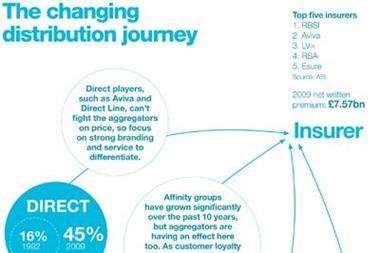The issues facing the motor market in the year ahead
1. Rates
Rise in premiums
The motor market has hardened over the past year, with many insurers reporting rate increases of 30% and above. The controversial European Court of Justice ruling outlawing pricing based on gender is likely to generate further premium increases when it comes into play next year.
Towers Watson consultant actuary Ryan Warren says: “Given the other difficulties that insurance companies have gone through recently, particularly the bodily injury claims cost increases, it is likely that increasing costs of the ruling will be passed directly to the customer.”
He adds that there will be major price increases, with younger female drivers charged premium increases of around 40% according to the Confused.com/Towers Watson Insurance Price Index.
2. Gender ruling
Reassessing risk
As a result of the ECJ ruling, insurers will be forced to look at new ways of pricing other than gender, and this will demand more sophisticated forms of data analysis. PricewaterhouseCoopers actuarial director Mohammed Khan explains there are a host of rating factors other than gender that insurers will now have to look at more closely, including the driver’s experience, age, the mileage and number of accidents.
He says: “They will look at the factors they already selected premiums from and make more use of that. They will analyse data more and in different ways.”
This could create a disparity in rates, according to Towers Watson’s Warren. “When this comes into play, different insurers will have adopted different strategies and we are going to see quite different pricing propositions. For the first few months, you will see quite a disparity in rates.”
3. Technology
Adjusted pricing
The cost of complying with the ECJ ruling, coupled with claims inflation, will force insurers to look at new ways of pricing. Expect to see insurers embrace the concept of telematics or ‘pay as you drive’, where the driver is priced according to their mileage.
Warren says: “Insurers will react differently, as there are a number of strategies that they could explore to differentiate prices without reference to gender. One such strategy might be in the telematic product offering where the price is dependent on actual driving behaviour. People are also likely to be more amenable to using telematics if they feel that otherwise they will be subsidising the insurance costs of others.”
4. Sales
Greater innovation
In the face of a challenging market, insurers will be under pressure to come up with innovative solutions to trade profitably. Expect to see more insurers bundling car insurance in a package with other products when targeting customers.
PwC’s Khan says: “I can see SME insurers pursuing innovative solutions, such as bundling or cross-selling items. You will see some insurers trying to test it before the date that the ECJ ruling kicks in. There is no reason why you can’t go to an insurer and get all of your insurance, including household, travel and car, and with pet thrown in as well.”
Some carriers may look to continental business models for inspiration on how to drum up profits. KPMG insurance partner Mark Winlow points out that Allianz has signed a deal with Ford, which means that new technology placed in the car will alert the insurer immediately when an accident takes place. He says: “This reduces the access to third party by non-insurers and will give those insurers that have deals with motor manufacturers an advantage.”
5. Regulation
New regime
Next year, the sector will wave good bye to the FSA, and welcome two new bodies: the Financial Conduct Authority (FCA), which will regulate the financial conduct of all financial services firms, including insurers, and the Prudential Regulation Authority (PRA), responsible for the authorisation and supervision of financial institutions, including insurers. Beachcroft head of strategic litigation Andrew Parker believes the new regime could create confusion for insurers.
He says: “Insurers that are regulated by both entities will want very clear guidelines as to who governs what, so they don’t have to comply with two sets of requirements.”
6. Recruitment
War for talent
In the beleaguered motor market, underwriters that can grow a business profitably are in high demand. KPMG’s Winlow says that those who stand out from their peers should see their cache soar in the marketplace.
He says: “There will be a fight for quality underwriters who have proved a success and can grow a book of business. Those underwriters who can demonstrate they understand the market and can be profitable will be in high demand. Expect to see some high-profile poaching over the next few months.”
7. Claims
Reform afoot
The Ministry of Justice’s road traffic accident portal, which fast-tracks claims worth up to £10,000, is widely expected to extend to those worth up to £25,000 – and the government is considering extending to £50,000. Beachcroft’s Parker points out that this could create headaches for insurers, as claims within this higher cost band are usually more complicated.
In addition, the Legal Services Commission’s long-awaited verdict on referral fees is expected in the coming months. Insurers were up in arms following its apparent green-lighting of the practice in a preliminary report last year. If it does a U-turn, motor insurers will find themselves in a tricky situation. A clampdown on referral fees is recognised as a long-term benefit for the sector, but it will hit motor insurers reliant on referral fees as a supplementary income.
8. Credit hire
CHOs squeezed
Last year was a bad year for credit hire. In the high-profile rulings of Beechwood Birmingham Ltd v Hoyer Group Ltd and Darren Bent, the courts weighed heavily in favour of insurers.
Berrymans Lace Mawer partner Ruth Graham believes that credit hire operators (CHOs) will have to get used to a harsher climate, and says that insurers have been encouraged by recent court successes and are refusing to yield to the demand of CHOs. This, says Graham, will force the credit hire market to look again at their prices and reduce their expectations. “This will bring great savings to insurance companies.”
Hosted by comedian and actor Tom Allen, 34 Gold, 23 Silver and 22 Bronze awards were handed out across an amazing 34 categories recognising brilliance and innovation right across the breadth of UK general insurance.














































No comments yet